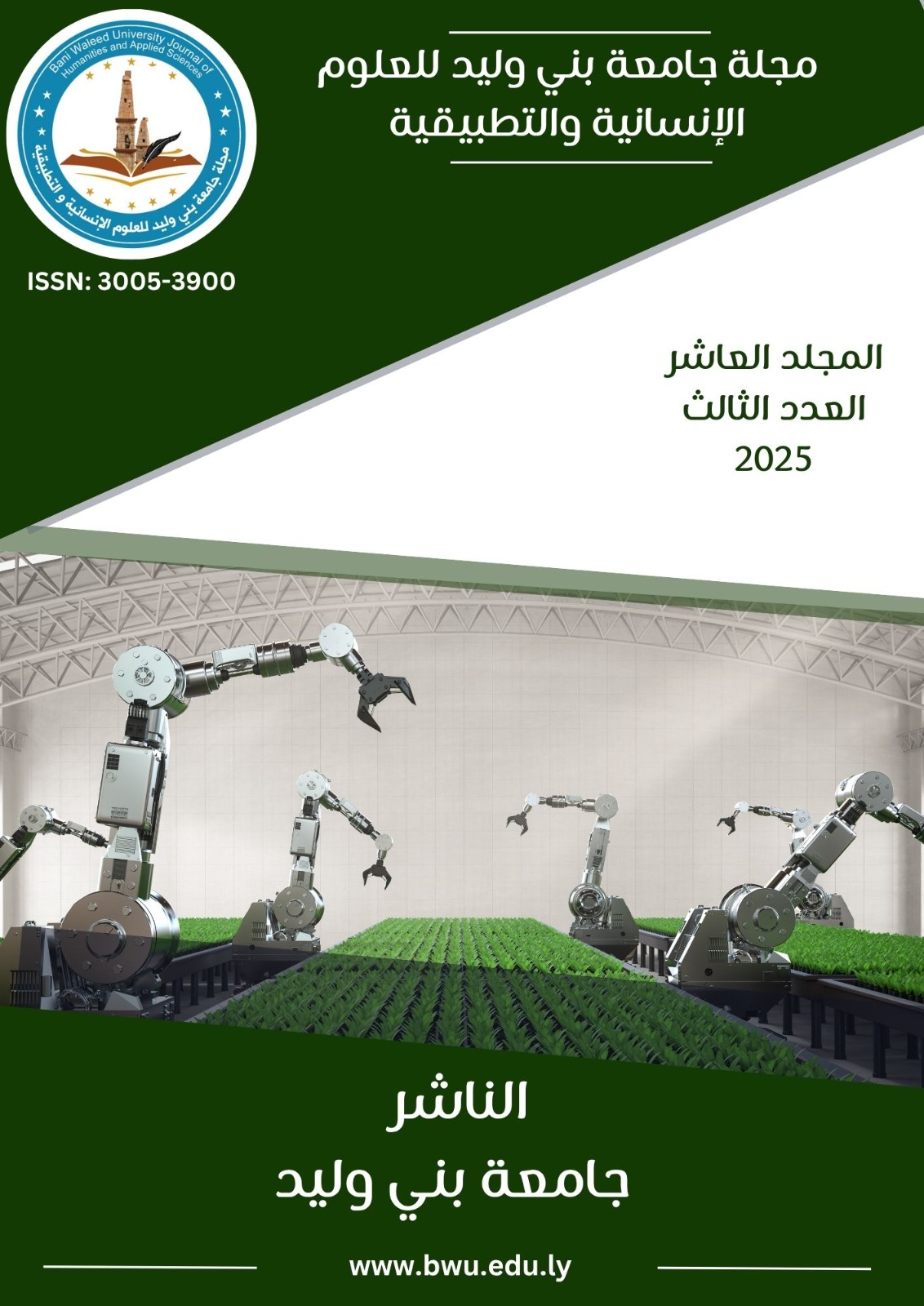Corpus-based Analysis of Three Synonyms in Quran Translation
DOI:
https://doi.org/10.58916/jhas.v10i3.846الكلمات المفتاحية:
Collocation، corpus، quranic translation، semantic prosody، synonymyالملخص
This study aims to demonstrate how a corpus-based approach offers an effective method for analyzing and enhancing existing English translations of the Qur'an. It addresses the specific challenges translators face when dealing with near synonyms. The research argues that the concept of semantic prosody (Sinclair, 2004) provides a valuable framework for resolving these difficulties. The central hypothesis is that each near-synonymous word in the Qur’an carries distinct connotations based on its lexical context.
By using a computerized concordancer, which allows for extensive searches of large text corpora, the study explores how words acquire meaning from the contexts in which they appear. This aligns with Firth’s (1968) well-known notion that “you shall know a word by the company it keeps.” Modern dictionaries increasingly rely on corpora to capture such contextual meanings.
This comparative descriptive analysis focuses on the Qur'anic Arabic term ḥijāb and its near synonyms sit'r and ghiṭā, examining how these are translated into English in the works of Pickthall and Sahih International, as available on a public website. The analysis uses componential analysis to investigate the semantic distinctions among these terms.
The findings reveal that the translators often do not differentiate clearly between these synonyms, commonly using terms like “cover,” “partition,” or “veil” interchangeably. The study proposes using “veil” specifically for ḥijāb, as it conveys the idea that what is veiled holds value. For sit'r, Pickthall’s translation “shelter” is recommended because it effectively communicates the meaning of complete coverage. As for ghiṭā, the term “membrane” is suggested based on its semantic prosody, particularly because it implies a covering of the eyes.
التنزيلات
المراجع
English Books :
Altenberg B. & S. Granger (eds.) (2002). Lexis in Contrast. Corpus-based approaches. Studies in Corpus Linguistics 7. Benjamins: Amsterdam & Philadelphia.
Sinclair, (2004). Trust the Text., London: Routledge.
Cruse,. D.A. (1986). Lexical Semantic. Cambridge: Cambridge University Press.
Firth, J.R. (1957). Modes of Meaning: in papers in linguistics. london: Oxford University Press.
Partington, A.(1998). Patterns and Meaning: Using Corpora for English Language and teaching. Philadelphia: John Benjamins.
Palmer, F. (1981).Semantics. (2nd ed). Cambridge: Cambridge University Press.
Lyons, J. (1968). Introduction to Theoretical Linguistics. Cambridge: Cambridge University press.
Louw, B. (1993). Irony in Text or Insincerity in the Writer: The Diagnostic Potential of Semantic Prosodies, In Baker et al. (eds.) 157-176.
Kennedy, G. (1998). An Introduction to Corpus Linguistics. London: Addison Welsey Longman.
Al-Damghani (1980), Dictionary of the Qur’an, or the reform of faces and counterparts -1 in the Holy Qur’an . dar aleilm lilmalayin bayrut ,, altabeat althaalithat mayu 1980. House of knowledge for millions of Beirut . Third edition, May 1980. Aldamghaniu qamus alquran aw asilah alwujuh walnazayir fi alquran alkarim
Baker,Paul (ed.). (2009).Contemporary Studies in Linguistics : Contemporary Corpus.Linguistics. London, GBR: Continuum International Publishing , 2009.
Biber D et al. (1998), Corpus linguistics : Investigating language structure and use.Cambridge university Press
.Palmar, F. R. (1976). Semantics. Cambridge, UK: Cambridge University Press -12 .J.
Stewart, Dominic (2010), Semantic Prosody: A Critical Evaluation .Routledge Taylor & Francis Group . New York London
Younis, N. & McEnery, T. & Hardie,A. (eds.). (2020). Semantic Prosody as a Tool for translating Prepositions in the Holy Qurʾan: A Corpus-Based Analysis. Published online by Cambridge University Press: 11 November 2020.
Alhusaiyan, E. A. (2023). Semantic prosody in the Holy Qur’an: A corpus study of the collocations and meanings of the verb waqa’a (‘fell’). Arab World English Journal for Translation & Literary Studies, 7(4), 19–33. https://doi.org/10.24093/awejtls/vol7no4.2 journal.translationstudies.ir+11works.bepress.com+11papers.ssrn.com+11
Alshahrani, H. J. A. (2020). The semantic prosody of natural phenomena in the Qur’an: A corpus-based study (Unpublished doctoral thesis). University of Leeds. https://etheses.whiterose.ac.uk/26745/ etheses.whiterose.ac.uk
Hizbullah, N., & Mardiah, Z. (2020). Al-Qur’an translation parallel corpus for the development of Qur’an translation studies in Indonesia. Proceedings of the 2nd International Conference on Quran and Hadith Studies… ICONQUHAS & ICONIST, 2020. https://doi.org/10.4108/eai.2-10-2018.2295536 eudl.eu
Younis,N. (2011). Different Morphological Forms in the Holy Qur’an : Should they be Translated the Same? Department of English , Faculty of Education, Ain Shams University . Al-Alsun International Conference ,2011. Journal of Scientific Reseach In Arts.
Journals :
Abu-Melhim, A & Al-Omari, S. (2014)." Synonymy in English and Arabic with Reference to the -1 Holy Qur'an: A Contrastive Study". Theory and Practice in Language Studies, Vol. 4, No. 12, pp. 2619-2626, December 2014 © 2014 ACADEMY PUBLISHER Manufactured in Finland. Department of English Language and Literature, Irbid University College, Al-Balqa’ Applied University, Irbid, Jordan
Baker ,Mona.(2004) . A corpus-based view of similarity and difference in translation . International Journal of Corpus Linguistics 9:2 (2004)167-193 .John Benjamins Publishing Company
Geoffrey, W. (2010) . Many rooms with corpora . Université de Bretagne Sud . -.International Journal of Corpus Linguistics 15:3 John Benjamins Publishing Company
Tongnini-Bonelli, Elena (2001) , Studies in Corpus Linguistics , Volume 6: Corpus Linguistics at Work. Amsterdam , NLD: John Benjamin's Publishing Company .
Alasmari, J, Watson, J.C.E & Atwell, E. (2018). A Contrastive Study of the Arabic and English Verb Tense and Aspect A Corpus-Based Approach. PEOPLE: International Journal of Social Sciences, 3(3), 1604-1615. Alasmari et al.Volume 3 Issue 3, pp.1604-1615Date of Publication: 20th . PEOPLE: International Journal of Social SciencesISSN 2454-5899
Websites:
https://corpus.quran.com/search.jsp?q=%D9%88%D8%B1%D8%A7%D8//1 %A1
//https://www.tyndalearchive.com/TABS/Lane/ 2
)Arabic-English Lexicon by Edward William Lane (London: Willams & Norgate 1863 :QURAN EXEGESIS
https://www.alro7.net/ayaq.php?langg=arabic&sourid=83&aya=15












